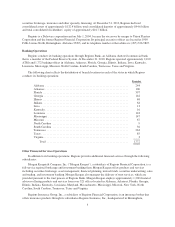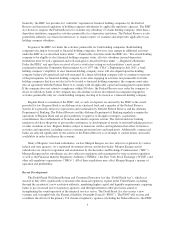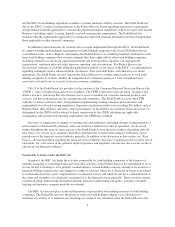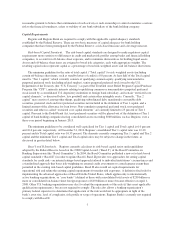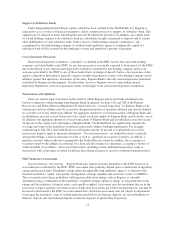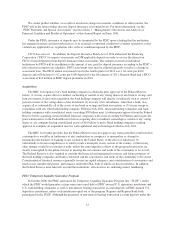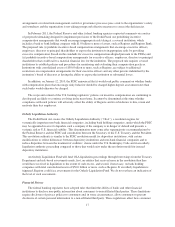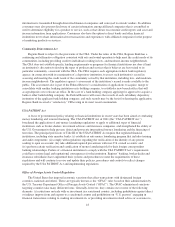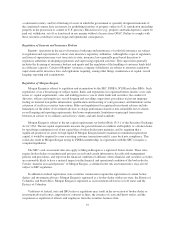Regions Bank 2010 Annual Report Download - page 27
Download and view the complete annual report
Please find page 27 of the 2010 Regions Bank annual report below. You can navigate through the pages in the report by either clicking on the pages listed below, or by using the keyword search tool below to find specific information within the annual report.Support of Subsidiary Banks
Under longstanding Federal Reserve policy which has been codified by the Dodd-Frank Act, Regions is
expected to act as a source of financial strength to, and to commit resources to support, its subsidiary bank. This
support may be required at times when Regions may not be inclined to provide it. In addition, any capital loans
by a bank holding company to its subsidiary bank are subordinate in right of payment to deposits and to certain
other indebtedness of such subsidiary bank. In the event of a bank holding company’s bankruptcy, any
commitment by the bank holding company to a federal bank regulatory agency to maintain the capital of a
subsidiary bank will be assumed by the bankruptcy trustee and entitled to a priority of payment.
Cross-Guarantee Provisions
Each insured depository institution “controlled” (as defined in the BHC Act) by the same bank holding
company can be held liable to the FDIC for any loss incurred, or reasonably expected to be incurred, by the FDIC
due to the default of any other insured depository institution controlled by that holding company and for any
assistance provided by the FDIC to any of those banks that is in danger of default. Such a cross-guarantee claim
against a depository institution is generally superior in right of payment to claims of the holding company and its
affiliates against that depository institution. At this time, Regions Bank is the only insured depository institution
controlled by Regions for this purpose. If in the future, however, Regions were to control other insured
depository institutions, such cross-guarantee claims would apply to all such insured depository institutions.
Transactions with Affiliates
There are various legal restrictions on the extent to which Regions and its non-bank subsidiaries may
borrow or otherwise obtain funding from Regions Bank. In general, Sections 23A and 23B of the Federal
Reserve Act and Federal Reserve Regulation W require that any “covered transaction” by Regions Bank (or its
subsidiaries) with an affiliate must be secured by designated amounts of specified collateral and must be limited
to (a) in the case of any single such affiliate, the aggregate amount of covered transactions of Regions Bank and
its subsidiaries may not exceed 10 percent of the capital stock and surplus of Regions Bank, and (b) in the case of
all affiliates, the aggregate amount of covered transactions of Regions Bank and its subsidiaries may not exceed
20 percent of the capital stock and surplus of Regions Bank. The Dodd-Frank Act significantly expands the
coverage and scope of the limitations on affiliate transactions within a banking organization. For example,
commencing in July 2011, the Dodd-Frank Act will require that the 10 percent of capital limit on covered
transactions begin to apply to financial subsidiaries. “Covered transactions” are defined by statute to include,
among other things, a loan or extension of credit, as well as a purchase of securities issued by an affiliate, a
purchase of assets (unless otherwise exempted by the Federal Reserve) from the affiliate, the acceptance of
securities issued by the affiliate as collateral for a loan, and the issuance of a guarantee, acceptance or letter of
credit on behalf of an affiliate. All covered transactions, including certain additional transactions (such as
transactions with a third party in which an affiliate has a financial interest), must be conducted on market terms.
FDIC Insurance Assessments
Deposit Insurance Assessments. Regions Bank pays deposit insurance premiums to the FDIC based on an
assessment rate established by the FDIC. FDIC assessment rates generally depend upon a combination of regulatory
ratings and financial ratios. Regulatory ratings reflect the applicable bank regulatory agency’s evaluation of the
financial institution’s capital, asset quality, management, earnings, liquidity and sensitivity to risk (“CAMELS”).
The assessment rate for large institutions with long-term debt issuer ratings, such as Regions, is currently
determined using a combination of the institution’s weighted average regulatory ratings, its long-term debt issuer
ratings and the institution’s financial ratios, each equally weighted. Assessment rates for institutions that are in the
lowest risk category currently vary from seven to twenty-four basis points per $100 of insured deposits, and may be
increased or decreased by the FDIC on a semi-annual basis. Such base assessment rates are subject to adjustments
based upon the institution’s ratio of (i) long-term unsecured debt to its domestic deposits, (ii) secured liabilities to
domestic deposits and (iii) brokered deposits to domestic deposits (if greater than 10 percent).
13


